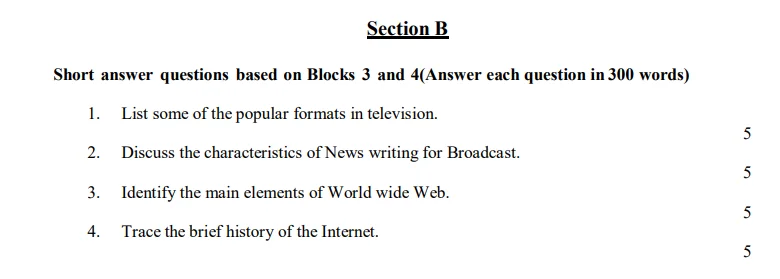BEGG 171 SOLVED IGNOU ASSIGNMENT FREE PART 2

Dive into Section B of Media and Communication Skills BEGG 171 SOLVED IGNOU ASSIGNMENT FREE PART 2 with our meticulously crafted IGNOU Solved Assignments 2024. Navigate short answer questions from Blocks 3 and 4 with precision and depth. Explore popular television formats, dissect the characteristics of news writing for broadcast, identify the main elements of the World Wide Web, and trace the brief history of the Internet. Each answer is carefully presented within 300 words, providing a comprehensive understanding of the course material.

Short answer questions based on Blocks 3 and 4 (Answer each question in 300 words)
Q.1 List some of the popular formats in television.
Ans. Television, as a dynamic medium, offers various formats to cater to diverse audience preferences. These formats have evolved over the years, shaping the landscape of television programming. Here are some popular television formats:
1. Drama Series:
– This is a narrative format where scripted stories unfold over multiple episodes, creating engaging and immersive storytelling experiences. Examples include “Breaking Bad,” “Game of Thrones,” and “Stranger Things.”
2. Sitcom (Situation Comedy):
– Sitcoms are humorous television series featuring a recurring set of characters who find themselves in comedic situations. Classic examples include “Friends,” “The Simpsons,” and “The Big Bang Theory.”
3. Reality Shows:
– Reality television involves real people, often in unscripted situations. Subgenres include competition shows (“Survivor,” “The Amazing Race”), docuseries (“Keeping Up with the Kardashians,” “Queer Eye”), and lifestyle shows (“The Real Housewives” franchise).
4. Talk Shows:
– Hosted by a presenter, talk shows feature discussions, interviews, and often audience participation. Popular examples include “The Oprah Winfrey Show,” “The Ellen DeGeneres Show,” and “The Tonight Show Starring Jimmy Fallon.”
5. News and Current Affairs:
– News programs provide updates on current events, politics, and global affairs. Examples include “CNN Newsroom,” “BBC World News,” and “The Daily Show with Trevor Noah.”
6. Game Shows:
– Game shows involve contestants participating in various challenges or answering questions to win prizes or cash. Iconic examples include “Jeopardy!,” “Wheel of Fortune,” and “Who Wants to Be a Millionaire.”
7. Documentaries:
– Documentary formats present factual content in a narrative style, exploring real-world events, people, or phenomena. Examples include “Planet Earth,” “Making a Murderer,” and “The Last Dance.”
8. Anthology Series:
– Anthology series feature standalone episodes or seasons, each with a different storyline and set of characters. “Black Mirror” and “The Twilight Zone” are notable examples.
9. Soap Operas (Daytime Dramas):
– Soap operas are serialized dramas typically broadcast during the day, featuring interconnected storylines and a large ensemble cast. Examples include “Days of Our Lives,” “The Young and the Restless,” and “General Hospital.”
10. Variety Shows:
– Variety shows offer a mix of musical performances, comedy sketches, and guest appearances. Examples include “Saturday Night Live,” “The Ed Sullivan Show,” and “The Carol Burnett Show.”
11. Animated Series:
– Animated series use animation to bring fictional or fantastical stories to life. Examples include “The Simpsons,” “Rick and Morty,” and “SpongeBob SquarePants.”
12. Mini-Series:
– Mini-series are short-run programs with a set number of episodes, often telling a complete story. Examples include “Chernobyl,” “Band of Brothers,” and “The Queen’s Gambit.”
These television formats showcase the diversity of content available to viewers, reflecting a blend of genres and styles that cater to various tastes and interests.
Q.2 Discuss the characteristics of News writing for Broadcast.
Ans. Characteristics of Broadcast News Writing: Precision in a Time-Critical Medium
Broadcast news writing demands a distinct set of characteristics tailored for a medium where information is conveyed through spoken words and visuals. Here are key features that define news writing for broadcast:
1. Clarity and Conciseness:
– Broadcast news stories require clear and concise language. Every word counts, as broadcasts have limited time slots. Information is delivered succinctly to ensure viewers or listeners quickly grasp the essential details.
2. Inverted Pyramid Structure:
– The inverted pyramid structure, with the most critical information presented first, is vital in broadcast news. This ensures that even if the audience tunes in for a short duration, they receive the core facts.
3. Active Voice:
– Using the active voice adds immediacy and energy to the news. It engages the audience by emphasizing who is doing the action, creating a sense of presence and urgency.
4. Visual Storytelling:
– Broadcast news integrates visuals seamlessly. The writing complements images, videos, and graphics to enhance the storytelling. Descriptive language is chosen to paint a vivid picture for the audience.
5. Attribution and Sourcing:
– Attribution is crucial in broadcast news writing. Clear and immediate attribution of information to its source builds credibility. It informs the audience about the reliability of the information presented.
6. Short Sentences and Paragraphs:
– Long, complex sentences are avoided. Instead, short sentences and paragraphs facilitate easy understanding. This structure aids both the audience’s comprehension and the news anchor’s delivery.
7. Consistency in Style:
– Consistency in style is maintained to create a polished and professional presentation. The writing adheres to established journalistic standards, ensuring uniformity across different stories.
8. Natural Language:
– Broadcast news aims for a conversational tone. The language used is natural and accessible, fostering a connection between the broadcaster and the audience. Formalities are minimized to enhance relatability.
9. Timeliness:
– Broadcast news thrives on immediacy. Timeliness is not just about delivering the latest information but also ensuring that the audience receives updates promptly, reflecting the rapidly evolving news cycle.
10. Emphasis on Lead:
– The lead, or opening segment, is meticulously crafted. It encapsulates the core of the story and grabs the audience’s attention. The lead sets the tone for the entire news piece.
11. Avoiding Jargon:
– Jargon and overly technical language are avoided unless the target audience is familiar with the terms. The goal is to make news accessible to a broad spectrum of viewers or listeners.
12. Pacing and Rhythm:
– Broadcast news has a rhythmic quality. The pacing is carefully considered, allowing for a smooth and engaging delivery. This rhythmic flow is achieved through a balance of words, pauses, and transitions.
In summary, news writing for broadcast is characterized by its succinct, visually integrated, and immediately engaging nature. The precision demanded by the medium, coupled with the importance of delivering information in a timely manner, shapes the distinct features of broadcast news writing.
Q.3 Identify the main elements of the World wide Web.
Ans. The World Wide Web (WWW) is a vast system of interlinked hypertext documents, images, and multimedia content accessed via the internet. Its evolution has transformed the way we access and share information. Here are the main elements that constitute the World Wide Web:
1. Hypertext and Hyperlinks:
– The foundation of the WWW lies in hypertext, allowing documents to be interconnected through hyperlinks. Hyperlinks are clickable elements that navigate users from one document to another, enabling the web’s non-linear structure.
2. Uniform Resource Locator (URL):
– URLs serve as addresses for web resources, allowing users to locate and access specific documents or pages. A URL typically consists of a protocol (e.g., “http://” or “https://”), domain name, and path.
3. Web Browsers:
– Web browsers are software applications that enable users to access and interact with content on the web. Examples include Google Chrome, Mozilla Firefox, and Microsoft Edge.
4. Web Servers:
– Web servers store and deliver web content to users upon request. They respond to HTTP (Hypertext Transfer Protocol) requests from browsers, facilitating the retrieval of web pages and other resources.
5. HTML (Hypertext Markup Language):
– HTML is the standard markup language used to create and structure web content. It defines the elements and layout of a web page, including text, images, links, and multimedia.
6. CSS (Cascading Style Sheets):
– CSS complements HTML by controlling the presentation and layout of web pages. It enables the styling of elements, such as fonts, colors, and spacing, providing a consistent look and feel.
7. Web Standards:
– Web standards, established by organizations like the World Wide Web Consortium (W3C), ensure consistency and compatibility across different browsers. These standards guide the development of HTML, CSS, and other web technologies.
8. Web Hosting:
– Websites are hosted on servers, and web hosting services provide the infrastructure and resources necessary for a website to be accessible on the internet.
9. Search Engines:
– Search engines, such as Google, Bing, and Yahoo, index and organize web content. Users can search for information, and the search engine returns relevant results based on algorithms.
10. Web Development Frameworks:
– Frameworks like React, Angular, and Vue.js facilitate the development of dynamic and interactive web applications. They enhance the efficiency of web development by providing reusable components and tools.
11. Web 2.0:
– Web 2.0 represents a shift in the web’s evolution, emphasizing user-generated content, collaboration, and interactivity. Social media platforms, wikis, and blogs exemplify Web 2.0 principles.
12. E-commerce Platforms:
– Platforms like Shopify, WooCommerce, and Magento enable businesses to establish and manage online stores. E-commerce has become a significant component of the web, facilitating online transactions.
13. Web Security Protocols:
– Security protocols like HTTPS (Hypertext Transfer Protocol Secure) encrypt data transmitted between web servers and browsers, ensuring the confidentiality and integrity of information.
14. Responsive Web Design:
– With the prevalence of diverse devices, responsive web design ensures that websites adapt to different screen sizes and provide a seamless user experience on desktops, tablets, and mobile devices.
In summary, the World Wide Web comprises a complex ecosystem of interconnected elements that work together to facilitate the creation, dissemination, and retrieval of information on a global scale. The continuous evolution of these elements contributes to the dynamic nature of the web.
Q.4 Trace the brief history of the Internet.
Ans. The history of the internet is a fascinating journey that spans several decades, marked by key technological advancements and transformative developments:
1. 1960s – The Precursors:
– The concept of the internet began with the development of packet-switching networks. The Advanced Research Projects Agency (ARPA) initiated the ARPANET project in the late 1960s, creating a decentralized network that could withstand nuclear attacks.
2. 1970s – Birth of ARPANET:
– In 1971, ARPANET sent its first message between two computers, marking the birth of the internet. Email communication was introduced, and the @ symbol became synonymous with online communication.
3. 1980s – TCP/IP Protocols:
– The Transmission Control Protocol (TCP) and Internet Protocol (IP) were standardized in the 1980s. This set the foundation for a global network of interconnected networks, leading to the term “internet.”
4. 1989 – World Wide Web (WWW):
– Tim Berners-Lee, a computer scientist at CERN, proposed the World Wide Web in 1989. He developed HTML (Hypertext Markup Language), the first web browser, and the first web server, laying the groundwork for the modern web.
5. 1990s – Commercialization and Expansion:
– The 1990s saw the commercialization of the internet. The creation of web browsers like Netscape Navigator and the introduction of the graphical user interface (GUI) made the internet more user-friendly. E-commerce, email, and search engines emerged.
6. 1993 – Mosaic Browser:
– The release of the Mosaic web browser in 1993 significantly enhanced the accessibility and popularity of the World Wide Web. It allowed users to view text and images on the same page, making the web more visually appealing.
7. Late 1990s – Dot-Com Boom:
– The late 1990s witnessed the dot-com boom, characterized by a surge in internet-based companies and investments. However, this period also saw the dot-com bubble burst in the early 2000s, leading to a reassessment of internet business models.
8. 2000s – Broadband and Social Media:
– The 2000s saw widespread adoption of broadband internet, improving connection speeds and enabling richer multimedia experiences. Social media platforms like Facebook, Twitter, and YouTube emerged, transforming the way people connect and share information.
9. 2010s – Mobile Internet and Cloud Computing:
– The 2010s witnessed the rise of mobile internet, with smartphones becoming ubiquitous. Cloud computing allowed users to store and access data remotely, leading to the proliferation of online services and applications.
10. Present – Internet of Things (IoT) and 5G:
– The present era is characterized by the Internet of Things (IoT), where everyday objects are connected to the internet, and the ongoing rollout of 5G networks promises faster and more reliable internet connectivity.
The history of the internet is a testament to human innovation, collaboration, and the profound impact of technology on society. From its humble beginnings as a research project to the globally interconnected and digitally transformed landscape we experience today, the internet continues to evolve and shape the way we live, work, and communicate.
Also See This: BEGG 171 SOLVED IGNOU ASSIGNMENT FREE PART 3







